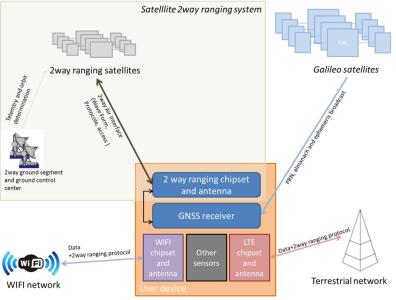Proof-of-concept of a space-based position augmentation with 2way communication
Programme
TDE
Programme Reference
T606-608ES
Prime Contractor
THALES ALENIA SPACE FRANCE
Start Date
End Date
Status
Closed
Country
France

Objectives
To perform a technological proof-of-concept of hybrid (terrestrial and space-based) systems for secure positioning using 2-way communication links with ranging functions
Description
Passive ranging relying on broadcast signaling is very attractive in terms of scalability, and allows to provide passive ranging capabilities to billions of users worldwide with 24 medium earth orbit satellites. Passive ranging rely on the fundamental assumption that the observed propagation delay relates to the geometric range. This is acceptable mainly under benign conditions.
To enhance resilience to spoofing of the positioning-navigation-timing (PNT) services, it appears attractive to implement 2-way communication and ranging systems to introduce secure bootstrapping and waypointing. Unfortunately, 2-way communications faces multiple-access limitations as the system must interact with each user. Wireless Local Area Network and Ultra-wideband provide 2-way ranging but in very limited coverage, while 4G Long Term Evolution only offers passive ranging signal. The introduction of a satellite component hybridized with terrestrial systems should be explored to augment European GNSS (EGNSS) with two-way ranging available globally.
Such system would not be exclusive of authentication capabilities of EGNSS, on the contrary, they would augment each other. The 2-way system can leverage on EGNSS authentication to significantly relax the multiple-access constraints: by combining continuous authenticated PNT from EGNSS with bootstrapping and regular waypoints from 2-way capabilities, the user does not need to connect continuously to the 2-way system (e.g. Few times per day). In densely populated area, the combination would rely on terrestrial components.
The capabilities of terrestrial distance bounding and 2-way ranging is investigated under Navisp. The proposed activity will support the vision build by Navisp by proving the concept of a space-component at breadboard level.
The activity will significantly spin-in techniques from wireless communication (e.g. Satcom, efficient multiple access technologies) and consider frequency and satellite diversity (e.g. L/S/C bands, different constellation parameters) to increase capacity.
This activity encompasses the following tasks
- Gather state-of-the-art and emerging technologies
- Identify, design and develop the innovative techniques
- Assess their performances
- Synthesis and recommend ways forward
Application Domain
Navigation
Technology Domain
6 - RF Subsystems, Payloads and Technologies
Competence Domain
5-Radiofrequency & Optical Systems and Products
Keywords
5-Disruptive Concepts on Positioning, Navigation and Timing
Initial TRL
TRL 1
Target TRL
TRL 3
Achieved TRL
TRL 4
Public Document
Final Presentation
Executive Summary
